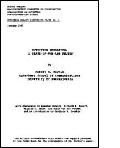
|
UN Standing Committee on Nutrition
Published in : 1985
Available in : English
How well or poorly does nutrition education work? Does it deal better with some nutrition problems than with others? Do some kinds of nutrition education produce better results than other kinds?
These are the sorts of questions addressed by Dr. Robert Hornik and a panel of distinguished discussants in the pages that follow. From their answers emerges a sense of change in the offing.
Documents :
Policy_paper_No_1.pdf (PDF, 301.29Kb)
Originally posted at : UNSCN - Publications
|
This resource is listed under:
Themes : Breastfeeding, general, Complementary feeding, general, Household Food Security and community nutrition, general, Interventions, general, Micronutrients, general, Nutrition and health/disease, general, Nutrition assessments and M&E, general, Nutrition planning, policy and programme, general, Undernutrition, general, Vulnerable groups, general, Behavior Change Communication, Breastfeeding counseling, Breastfeeding counseling, Food and nutrition policies and strategies, Hygiene, water and sanitation, Micronutrient deficiencies, Micronutrient deficiencies, Micronutrient Supplementation, Micronutrient Supplementation, Micronutrient Supplementation, Nutrition information and education, Nutrition information and education, Poverty, Programmes, Surveillance systems, Surveillance systems, Underweight
Life-cycle focus : Pregnancy, Infancy, Pre-school age, School age, Adulthood
Resource types : Normative guidance: Norms, standards, policies, Peer reviewed journals or papers, Reports, Scientific/background documents
Locations : Colombia, Jamaica, United Republic of Tanzania
Working groups : Breastfeeding and complementary feeding, Capacity Development in Food and Nutrition, Household Food Security, Micronutrients, Nutrition of School-Age Children
|